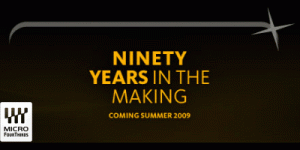Jag fick varning om spyware från min brandvägg när jag gick in på den sidan!
Hoppsan! Min dator (Mac OS 10.5.6 med Safari) har inget att invända. Sidan verkar lite väl ambitiös för att bara vara lurendrejeri, men det skadar ju inte att vara försiktig. Med risk för att bryta någon upphovsrätt så limmar jag in ett utdrag här nedan. Källa som ovan. Skribent: Dave Etchells, The Imaging Resource
"What's the major change?
As noted in our first news item on the Micro Four Thirds announcement, the biggest change here is that the mirror box has been eliminated (meaning that all Micro Four Thirds cameras will be LiveView-only, there won't be any direct optical path from the viewfinder through the camera lens. They'll thus technically be EVF cameras, similar to most non-SLR digicams.
By eliminating the mirror box, the "back focus distance" (or back focal length) of the lenses can now be reduced, and will be cut roughly in half from the equivalent dimension in the current Four Thirds system. Technically, back focus distance is defined as the distance from the vertex of the lens's rear element to the sensor, but for practical purposes, it's easiest to speak in terms of the distance from the lens mounting flange to the sensor surface. In current Four Thirds systems, this dimension is 40mm, in the Micro Four Thirds system, it will be 20mm.
The illustration at right (credit for this and others:Four-Thirds.org) shows schematically the difference between the current Four Thirds mount and the new Micro Four Thirds mount. On a camera.
Why are they doing this?
One of the first reasons consumers give for not making the move to an SLR is that SLRs are "too big." One of the original marketing points for the Four Thirds concept was that, by designing the system from the ground up to use a smaller sensor, lenses and bodies could be made much smaller than those for conventional SLRs, which are all based on dimensions taken from the 35mm film world. (Even reduced-frame cameras deviate only slightly from the size constraints imposed by the 35mm roots of other current SLR systems.)
Part of the reason that the original Four Thirds system hasn't resulted in much smaller cameras is that the 40mm back focus distance mandates rather large optics. It turns out that the physical size of camera lenses depends somewhat on the size image circle they must produce, but depends even more strongly on the back focus distance they're designed for. Reducing the back focus distance can dramatically decrease the size of the lenses needed to cover the Four Thirds frame. It also (obviously) reduces the thickness of the camera body itself.
The decrease in lens size isn't only in length: Lenses for the new system can be smaller in diameter as well, so the new mount is also 6mm smaller (44mm vs 50mm) than the original Four Thirds system called for. The illustration above compares the size of the new and old lens flanges.
Why didn't they do this in the first place?
When the Four Thirds system was developed, Olympus (one of the founding companies of the Four Thirds coalition) felt that telecentric lens designs were critical to producing the best image quality on electronic sensors. Telecentric lenses are unusual, in that light rays striking the imager surface all arrive perpendicular to the imager's surface. This is important for CCD sensors, because the multiple metallization and insulating layers used for that technology produce a chip surface with a very significant 3-D structure. This structure can actually cast shadows on the light-gathering areas of the chip if light rays arrive at a glancing angle. This leads to shading, and (when the microlenses are considered) possibly chromatic aberration effects and crosstalk between the camera's RGB color channels. Geometric distortion is also generally less in telecentric lens designs, and
Telecentric lenses aren't easy to make though, and having a greater back focal distance really helps in their design. - So the original Four Thirds lens specification dictated a rather large back focus distance.
Since that time though, some of the downsides of non-telecentric lenses have been mitigated by advances in image processing: Current camera CPUs are fast enough to do very sophisticated image processing to greatly reduce some of the image artifacts resulting from the use of non-telecentric lenses. At the same time, the NMOS-based image sensors developed by Panasonic (and others?) have a much flatter surface profile, and so are much less subject to problems with light arriving at higher angles of incidence.
The combination of these two factors means that many of the benefits of telecentric lens design are less compelling than they were only a few years ago."









